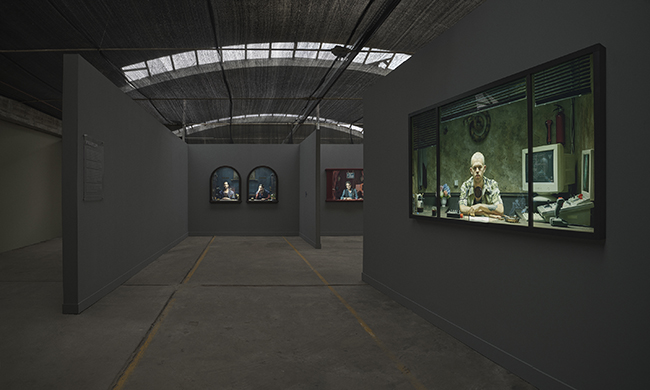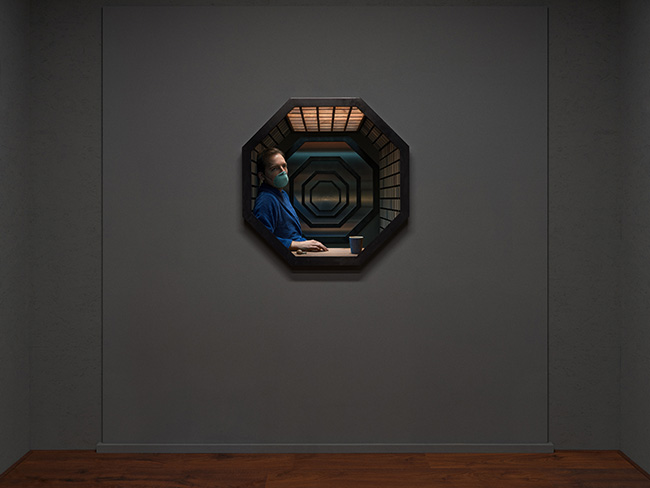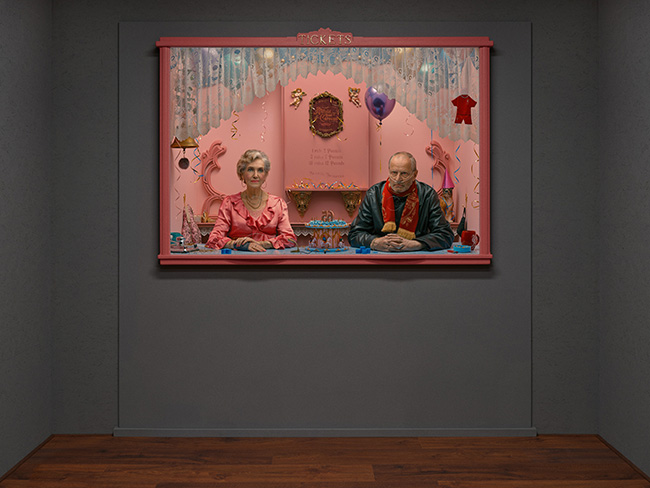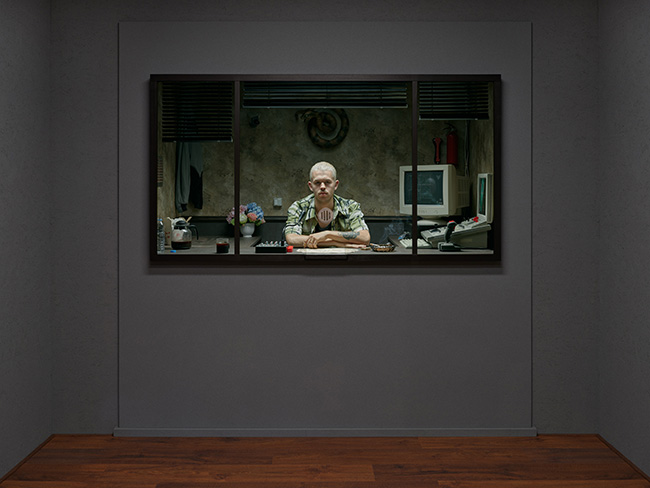
Dirk Hardy
Vivarium by Dirk Hardy: A journey into the image
TBILISI PHOTO FESTIVAL X FUTURES
Interview by René Mariam Nadareishvili
R. N.: Vivarium is a hyper realistic multifaceted project, which also reflects on the relation, the dichotomy between exhibited object and the viewer, as the images create the illusion that the viewer is also being observed by the character from the image. Miscellaneous details provoke a viewer to seek deeper connections between the characters and the objects. What was the main conceptual line at the start of the project?
D. H.: The moment when a project appears to me is usually a moment of empathy. So, I was at the beach in 2017. Everyone was having a good time and there was this one trampoline rental in the middle of the beach with this person sitting in a ticket booth, quite lonely. And this moment connected with me in a very empathic way. Usually, when looking at the world, I often have a feeling that as a photographer, on the one hand, I’m in the present moment, but on the other, I'm just an observer. I felt a connection with that moment of the man sitting in the booth. He was just witnessing life taking place and at the same time, he was someone that you could just freely observe behind the glass, almost like an aquarium. So, for me, that was when I didn't exactly know what I was going to do with the subject, but I did know that I had to let it sink in for a little bit and ask myself what this phenomenon was actually about. And then I went through quite a long research and artistic process. At first, I had an idea to make exteriors of ticket booths, put them in a public place, and have someone sitting in the booth and photograph it. But then I started designing one of these boots. I studied architecture before, so I was really comfortable with the design program. I made this booth come to life in the 3-D program. I was thinking this could also be very interesting not to show the exteriors of the booths, only the interiors. Later I came up with the idea of making them hyper realistic by printing, putting them in a light box, and even inserting the actual glass in the front. So, with this project, I started to think of photography in a different way. In the past, I was always constructing images in a very classical photographic way. However, for this project, I felt that I was discovering new terrain, not only in my photography, but I also was hoping that no one had ever done something like this before. While working on this project, many aspects of my personality, like the will to design, my empathy for the world, and my curiosity were combined. Now it is about whatever I want it to be, each episode has its own topic, has its own goal, its own mission, and the stories I'm able to tell, they feel infinite because I can decide where the booth is, where this person is sitting, what person is sitting there, what's the story about. Is it about the Dutch colonial past, or about how we look at gender and how people can be stuck in their bodies? So, there are all these topics that I focus on in the world and that concerns me. I feel like I'm able to show the complexity of the times that we live in, the complexity of our world, as there are all these different topics existing side by side, existing together, influencing each other. Usually, projects are trying to highlight a single topic, like, climate change or Black Lives Matter, or the ways of responding to these issues. In my opinion, with Vivarium I'm able to not only focus on an individual topic, but also show the whole spectrum, and therefore, I'm still not finished with the project. There are eight episodes for now and I work very slowly. It takes me four months to create one single episode with design, research, and construction, as I build all these worlds myself in my studio. That’s why I dive into each topic. The project can go any direction depending on what connects with me and how the world is evolving or what's happening in the world.

Vivarium Exhibition 2021-2022. MOYA. Oosterhout. Netherlands
D. H.: There are many simple similarities between Vivarium and my earlier work, and I'm constantly constructing worlds. And what I've also discovered when looking back at my work, that I'm making dioramas all the time. It's almost like I make the scene for a theatre, but I use photography. I think that’s what unifies my projects. I would highlight three things that connect me to the world and inspire the projects — my imagination, my observation, and my memory. So, in the end, it's all constructed in the studio, and I don't go out into the streets trying to document what's happening in the world, as I remember and connect the links in my mind. I meticulously construct every detail, each of them is a clue, a deeper layer, as a viewer you go on a kind of treasure hunt to really dive into the story while maintaining a kind of open narrative. That makes it very interesting, and I have to say, it’s a lot of fun to make these puzzles and make them so realistic that, at first, you're being tricked into thinking, hey, there's someone sitting there behind glass. And later, viewers discover a deeper meaning.

Dirk Hardy. Vivarium. Intermission. Episode 7. 2020
D. H.: What Vivarium did for me as an artist is unleash an unlimited amount of creativity because as long as I stay true to the hyper realistic formula, I can make a whole new world. I start with an empty studio every four months. And I have no idea where I'm going to end, so it's taking this artistic journey that usually took me much longer, because my projects were about a single topic, for example, Void. It took me a long time to make that series, but it was only focused around a single core, which was the elevator and human interaction or human behaviour in an elevator. But now I feel Vivarium allows me to make my work a lot more complex while maintaining the method that I always lean towards because of my architecture background. So, it feels like a very natural development, and I think, Vivarium is the project where everything comes together and where I really don't see the end of the line yet. I don't see the moment where it would bore me because of its openness and dynamic. It feels like a new project every time with each episode.

D. H.: Sure, there are actually two ways to talk about Vivarium. There's also the deep dive into these individual pieces because they are almost separate projects on their own. For example, the latest episode, Episode Eight. They are a couple selling tickets for a carousel, a Merry-go-round in Liverpool, the UK. The man is a huge Liverpool fan. Also, this booth is almost like a palace, it almost looks like an 18th-century French palace. The woman made the booth completely her own with all the silver, gold, and pink. Everything is very luxurious looking over the top. And He really holds on to his own identity, which is the football club, Liverpool. He’s wearing the scarf, and he's having the mug in front of him, the t-shirt stuck behind the glass. So, it's almost like he's trying to say to the world, I know that this booth completely looks like my wife's, but I also have an identity, I also want to express myself in my manly way. If you look closely in the middle of the work, there's this board hanging there, which has a carousel and on the top is a name. It says McNulty and Son. We discover from this board that it was actually his father who started the business and he followed the footsteps of his father, taking over his Merry-go-round ticket booth. He didn't choose his own occupation, his own path in life. Then he got married, and his wife took over the booth completely. It's quite frustrating for him. And he's not celebrating his birthday the way he would like to, because now everyone who's going to buy a ticket will wish him a happy birthday. But he doesn't want that attention because he's busy with the afterlife. They are celebrating a man's sixty-fifth birthday with a big cake with candles, they have just been blown out. There’s an existential issue, because I really think that the way we celebrate our birthdays as human beings is quite interesting, and we all celebrate this day in a different manner. Also, birthdays are quite a juxtaposed phenomenon. It’s also a reminder that someday we will die, someday we will have our last birthday and, in the end, it's just about how many turns the Earth makes around the Sun and how many of those you will be able to witness. And so, I thought it was a very nice starting point. That's also why I chose the carousel, the Merry-go-round as the main topic, and it's also why I called it the Wheel, it's also about the circulation of life. We really don’t know how many more birthdays he will be able to celebrate and at the same time, the woman is celebrating his life but simultaneously facilitating his death. There are many contradictions in the work that makes it very interesting for me. We see elements such as difficulty breathing, balloons filled with air, almost lifting him up into the space behind the curtain, which I feel can almost represent heaven. So, in the end, it has humor, a little bit of dark humour, if you ask me. That’s why I like making these booths myself and not using existing ticket booths because there's so much I can do with narratives, create stories, and clues. And what I think is very nice about the project is that everything is life-size, which means that we can really relate to all the objects in the booth and really connect with the human being sitting behind the glass. The image consists of one or two hundred pictures, images that were all stitched together. They make a high-resolution hyper realistic piece. For example, I photographed the man and the woman separately, so that I could choose the best combination of two images to make that moment that I had envisioned before. That gives me full control, almost like a painter. I was able to decide and redesign and reconsider my digital process, which takes a very long time. It takes weeks to put everything together and then to find the right combination of objects to make one composition that is then put into a window frame in front of a light box, of course. And then I have the glass panels made.

D. H.: It's episode one, it was actually my first attempt to make a Vivarium. I had figured out the formula in the computer with sketches and designs, but I had no idea if it would actually work the way I had intended to. So, as you may know with television series, the first episode is always called the pilot, to see if it would actually work on television. And if the series goes into production, they will make more episodes. That's why I thought it was fitting to name this work, the Pilot. It inspired me to make all these other Vivarium pieces and really started the project for me. This booth is very dark, kind of moody, almost like he's sitting in Plato's Cave. It's very quiet. Dark and ominous. But in my mind, he's selling tickets for a roller coaster. Judging by his appearance I'm not sure if I can trust him. and then we can see a keychain with his daughter's picture, we see a wedding ring around his finger. So, what we discover is that he looks very aggressive, has a rough exterior, he's actually a father, he's just a family man trying to make money for his family to survive and to pay rent, etc. While creating this episode, I was testing what it means to create a character and to create a space for that character. Details like, should there be smoke coming off the coffee, or should it be coffee that looks like it's been there for two weeks? Is he smoking? What's he doing? Also, I'm playing with the blinds that, like the three parts of the image, are almost like a triptych, like a Renaissance triptych. I was figuring out how to depict the world, so how the imagined world, the printed world with the blinds, would respond to the window frame. And as you see in the image, the window frame is something you can actually touch as a viewer.
Cover image: Dirk Hardy. Vivarium. Cinema Il Sogno: La Stella. Episode 5. 2020.
This series of articles are published in order to create new artistic opportunities for the Futures Talents - the photographers that are part of Futures platform. In 2020 Tbilisi Photo Festival has joined the FUTURES - Europe based photography platform co-funded by the Creative Europe program of the European Union. Futures bring together the global photography community to support and nurture the professional development of emerging artists across the world. The project implemented in partnership with Tbilisi Photography & Multimedia Museum.